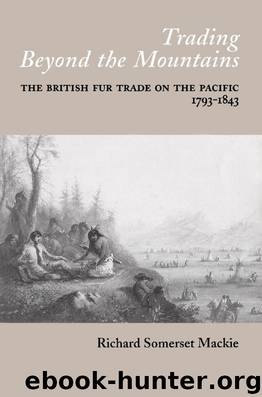Trading Beyond the Mountains: The British Fur Trade on the Pacific, 1793-1843 by Richard Somerset MacKie

Author:Richard Somerset MacKie [MacKie, Richard Somerset]
Language: eng
Format: epub
Published: 0101-01-01T00:00:00+00:00
1821
1822
1823
1824
1825
1826-9
1830 50 1831 334 1832 1,116 1833 2,385 1834 1,646 1835 3,302 1836 4,330 1837 7,198 1838 8,003 1839
1840 38,982 1841 39,729 1842 34,793 1843 40,732
Sources: 1821-5 figures are from York Factory, Accounts Current 1821-26, HBCA B.239/d/286; 1830-9 figures (including country produce figures) are from York Factory, Abstract of Accounts Current, 1830-1839, HBCA 6.239/01/547, fo. 18 (see also York Factory, Country Produce Account Book, 1828-1836, HBCA 6.239/01/491); 1840-4 figures are from 'General Result of Trade Northern Department and Columbia pr Country Accounts,' Ross Papers, BCARS
Crisis in the Fur Trade 253
lowed by substantial overhead expenses, especially shipping costs, insurance trade goods, and wages.26 In 1842, French traveller de Mofras learned that the 'initial cost of European merchandise used in trade with the Indians does not exceed £8,000 or £10,000.' The department's annual requisition for British trade goods was £10,399 in 1834 and £13,300 in 1838. At first, the requisitions were mainly for Indian trade goods. After the opening of a sale shop at Fort Vancouver and agencies at Oahu and Yerba Buena, however, they included an increasing number of British goods destined for non-Native sale. Simpson estimated the value of the 'general cargo' required for the 1841 shipment at between £18,000 and £2o,ooo.27
The company's accountants usually spent several years determining a post's final profits, owing to the long transport between London and the Columbia, and the time lapse between the furs' arrival and their sale. Requisitions had to be ordered years in advance and then subtracted from final gains; pelts might be auctioned in London a year or two after they were shipped; salmon and lumber were not always exported in the same year they were produced, and did not always sell immediately in Oahu; and transport and other departmental costs had to be subtracted from final auction and profits.
By 1843, sa^es °f salmon, lumber, and British goods at Oahu, Yerba Buena, and to the settlers near Fort Vancouver contributed materially to departmental profit. Such sales contributed at least £4,000 annually to total departmental profits: about £2,000 came from Oahu, and another £2,000 from Vancouver and Yerba Buena. New exports possessed an unstoppable momentum. In 1849, for example, Douglas estimated the value of the company's exports to Sitka and the Sandwich Islands at £10,000 and £8,000 respectively.28
Departmental patterns emerged and changed with time. Table 8 shows returns of outfit year 1844 (the figures refer to values, not final profits). Snake Party and Fort Nez Perces returns, previously substantial, were in decline, a reflection of the company's scorched earth frontier policy and trade disruptions caused by American overlanders using the company's Snake Brigade route.29 North West Coast returns (figures for Fort Simpson and the steamer Beaver) were considerably greater than those for the south coast (figures for forts Langley, Victoria, and Nisqually) - a reflection of the large, wealthy interior districts adjacent to the North West Coast, and of the milder climate and mountainous terrain in the
254 Trading Beyond the Mountains
south. Interior districts, especially New Caledonia and Colvile, generally offered a richer, more secure fur yield than did coastal districts.
Download
This site does not store any files on its server. We only index and link to content provided by other sites. Please contact the content providers to delete copyright contents if any and email us, we'll remove relevant links or contents immediately.
| Africa | Americas |
| Arctic & Antarctica | Asia |
| Australia & Oceania | Europe |
| Middle East | Russia |
| United States | World |
| Ancient Civilizations | Military |
| Historical Study & Educational Resources |
Cat's cradle by Kurt Vonnegut(14786)
Pimp by Iceberg Slim(13809)
Underground: A Human History of the Worlds Beneath Our Feet by Will Hunt(11850)
4 3 2 1: A Novel by Paul Auster(11823)
The Radium Girls by Kate Moore(11642)
Wiseguy by Nicholas Pileggi(5336)
American History Stories, Volume III (Yesterday's Classics) by Pratt Mara L(5141)
Perfect Rhythm by Jae(5084)
The Fire Next Time by James Baldwin(5034)
Paper Towns by Green John(4815)
Pale Blue Dot by Carl Sagan(4633)
A Higher Loyalty: Truth, Lies, and Leadership by James Comey(4568)
The Mayflower and the Pilgrims' New World by Nathaniel Philbrick(4288)
The Doomsday Machine by Daniel Ellsberg(4254)
Killers of the Flower Moon: The Osage Murders and the Birth of the FBI by David Grann(4199)
Too Much and Not the Mood by Durga Chew-Bose(4105)
The Sympathizer by Viet Thanh Nguyen(4100)
The Borden Murders by Sarah Miller(4033)
Sticky Fingers by Joe Hagan(3918)
